The Inner Nature of Music and the Experience of Tone
GA 283
Lecture IV
2 December 1922, Dornach
In recent discussions,1Refers to Rudolf Steiner's lectures, Man and the World of the Stars/the Spiritual Communion of Man, Anthroposophic Press, Spring Valley, NY. 1982. I pointed out that certain human functions appearing in early childhood are transformations of functions that man carries out in pre-earthly existence between death and a new birth. We see how, after birth, the child not fully adapted to the earth's gravity and equilibrium gradually develops to the point at which it becomes adjusted to this equilibrium, how it learns to stand and walk upright. The body's adaptation to the condition of equilibrium of earthly existence is something the human being acquires only after life on earth has begun. We know that the form of man's physical body is the result of a magnificent spiritual activity, which man, together with beings of the higher worlds, undertakes in the period between death and a new birth. What man forms in this way, however—that which becomes the spiritual seed, as it were, for his future physical earthly organism—does not yet contain the faculty of walking upright. That faculty is incorporated into the human being when he adapts himself after birth to the conditions of equilibrium and gravity of earthly existence.
In pre-earthly existence, orientation does not refer to walking and standing as it does here on earth. There, orientation refers to the relationship man has with angels and archangels and therefore to beings of the higher hierarchies. It is a relationship in which one finds oneself attracted more to one being, less to another; this is the state of equilibrium in the spiritual world. It is lost to a certain extent when man descends to earth. In the mother's womb, man is neither in the condition of equilibrium of his spiritual life nor yet in that of his earthly life. He has left the former and as yet has not entered the latter.
It is similar in the case of language; the language we speak here on earth is adjusted in every respect to earthly conditions, for this language is an expression of our earthly thoughts. These earthly thoughts contain earthly information and knowledge, and language is adapted to them during earthly existence. In pre-earthly existence, man has a language that does not actually emerge from within, that does not follow the exhalation. Instead, it follows spiritual inhalation, inspiration, something in pre-earthly existence that we can describe as corresponding to inhalation. It is a life within the Word of the universe, the universal language, from which all things are made.
As we descend to the earth, we lose this life within the universal language, and here we acquire the means that serve to express our thoughts, our earthly thoughts, and the human intellect, that is, the intellect among all human beings dwelling on earth. It is the same with the thoughts we have here as with the thinking. Thinking is adapted to earthly conditions. In pre-earthly existence we live within the weaving thoughts of the universe.
If we first focus on the mediating member of man, man's speaking, we can say that an essential part of the earth's culture and civilization lies in speaking. Through speaking, people come together here on earth; speaking is the bridge between two persons. Soul unites with soul. We feel that in speaking we have an essential aspect of life on earth; it is, after all, the earthly reflection of life in the Logos, in the Word of the universe. It is therefore particularly interesting to understand the connection between what man struggles to attain on earth as his language and the metamorphosis of this language found in pre-earthly life. The study of this relationship directs us to the inner organization of man, which stems from the elements of sound and tone. It is especially fitting that at this moment I can add the subject of man's expression through tone and word to the cosmological considerations we have been conducting for weeks. Today we have had the great pleasure of listening to a superb vocal recital here in our Goetheanum. As an expression of inner satisfaction over this gratifying artistic event, let me say something about the connection between man's life in that which corresponds to tone and sound in the spiritual.
If we observe the human organization as it is manifested on earth, it is a reflection of the spiritual through and through. Not only what man bears within himself but everything surrounding him in outer nature is a reflection of the spiritual. When man expresses himself in speech and song, he expresses his whole organization of body, soul and spirit as a revelation to the outside as well as to himself, to the inside. Man is completely contained, as it were, in what he reveals in sound and tone. How much he is contained within this is revealed when one goes into the details of what man is when he speaks or sings.
Let us begin by considering speech. In the course of humanity's historical evolution, speech has emerged from a primeval song element. The further we go back into prehistoric times, the more speech resembles recitation and finally singing. In very ancient times of man's earthly evolution, his sound and tone expressions were not differentiated into song and speech; instead, they were one. Man's primeval speech may be described as a primeval song. If we examine the present state of speech, which is already far removed from the pure singing element and has instead immersed itself in the prose element and the intellectual element, we have in speech essentially two elements: the elements of consonants and vowels. Everything brought out in speech is composed of the elements of consonants and vowels. The element of consonants is actually based on the delicate sculptural formation of our body [Körperplastik]. How we pronounce a B, a P, an L, or an M is based on something having a definite form in our body. In speaking of these forms, one is not always referring only to the apparatus of speech and song; they represent only the highest culmination. When a human being brings forth a tone or sound, his whole organism is actually involved, and what takes place in the song or speech organ is only the final culmination of what goes on within the entire human being. The form of the human organism could be considered in the following way. All consonants contained in a given language are always actually variations of twelve primeval consonants. In Finnish, for example, these twelve primeval consonants are preserved in a nearly pure state. Eleven are retained completely clearly; only the twelfth has become somewhat unclear. [Gap in transcript.] If the quality of these twelve primeval consonants is correctly comprehended, each one can be represented by a certain form. If they are combined, they in turn represent the complete sculptural form of the human organization. Not speaking symbolically at all, one can say that the human organism is expressed sculpturally through the twelve primeval consonants.
Actually, what is this human organization? Viewed from an artistic standpoint, it is really a musical instrument. Indeed, you can comprehend standard musical instruments, a violin or some other instrument, by looking at them fundamentally from the viewpoint of the consonants, by picturing how they are built, as it were, out of the consonants. When one speaks of consonants, one always feels something that is reminiscent of musical instruments, and the totality and harmony of all consonants represents the sculptural form of the human organism.
The vowel element is the soul playing on this musical instrument. When you observe the consonant and vowel element of speech, you actually discover a self-expression of the human being in each word and tone. Through the vowels, the soul of man plays on the “consonantism” of the human bodily instrument. If we examine the speech of modern-day civilization and culture, we notice that, to a large extent, the soul makes use of the brain, the head-nerve organism, when it utters vowels. This was not the case to such an extent in earlier times of human evolution. Let me sketch on the blackboard what takes place in the human head-nerve organism.
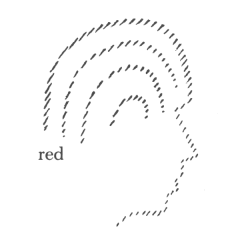
The red dotted lines indicate the head-nerve organism. They therefore represent the forces running along the nerve fibers of the head. This is a one-sided view of the whole matter, however. Another activity enters the one generated by the nerve fibers. This new activity is caused by our inhalation of air. Sketching it, we see that the air we inhale passes through the canal of the spinal cord, and the impact of the breathing process unites with the movements taking place along the nerve fibers. The stream of breath (yellow), which pushes upward through the spinal cord to the head, constantly encounters the nerve activity. Nerve activity and breathing activity are not isolated from each other. Instead, an interplay of both takes place in the head. Conditioned by everyday life, man has become prosaic, placing more value on the nerve forces, and he makes more use of his nervous system when he speaks. One could say that he “innergizes” [“innerviert,” makes inward] the instrument that forms the vowel streams in a consonantal direction. This was not the case in earlier epochs of human evolution. Man lived less in his nervous system; he dwelt more in the breathing system, and for this reason primeval speech was more like song. What man carries out in speech with the help of the “innergizing” of his nervous system he draws back into the stream of breathing when he sings today; he then consciously brings into activity this second stream (sketched in yellow), the stream of breathing. When vowel sounds are added to producing the tone, as in the case of singing, the element of breathing extends into the head and is directly activated from there; it no longer emerges from the breath. It is a return of prosaic speech into the poetic and artistic element of the rhythmic breathing process.
The poet still makes an effort to retain the rhythm of breathing in the way in which he formulates the language of his poems. A person who composes songs takes everything back into breathing, and therefore also into the head-breathing. When man shifts from speaking to singing, he undoes in a certain way what he had to undergo in adapting speech to earthly conditions. Indeed, song is an earthly means of recalling the experience of pre-earthly existence. We stand much closer to the spiritual world with our rhythmic system than with our thinking system. It is the thinking system that influences speech which has become prosaic.
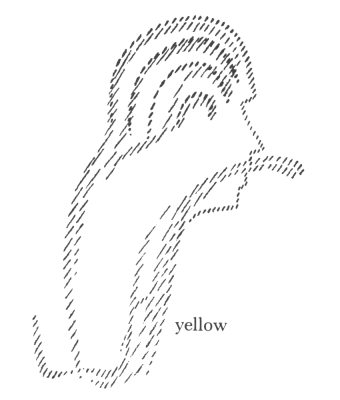
When producing vowel sounds, we actually push what lives in the soul toward the body, which serves as the musical instrument only by adding the consonant element. Surely you can feel how a soul quality is alive in every vowel and how you can use the vowel element by itself. The consonants, on the other hand, tend to long continuously for the vowels. The sculptural instrument of the body is really dead unless the vowel or soul element touches it. Many details point to this: take, for instance, the word “mir” (“mine”; pronounced “meer” in high German), and look at how it is pronounced in some Central European dialects. When I was a little boy, I couldn't imagine that the word was spelled mir. I always spelled it mia, because in the r is contained the longing for the a.
If we see the human organism as the harmony of the consonants, everywhere we find it in the longing for vowels and therefore the soul element. Why is that? The human organism while here on earth must adapt its sculptural form to earthly conditions. Earthly equilibrium and the configuration of earthly forces determine its shape. Yet, it is really shaped out of the spiritual, and only through spiritual scientific research can one perceive what actually takes place. I shall try to make this clear for you with a diagram. The soul element (red), which expresses itself in vowels, pushes against the element of consonants (yellow). The element of consonants is shaped sculpturally according to earthly conditions.
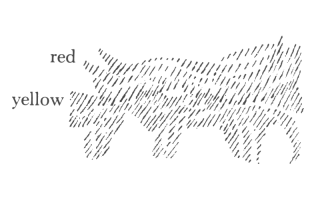
If one ascends to the spiritual world in the way described in my book, Knowledge of the Higher Worlds and Its Attainment, one first acquires imagination, imaginative cognition. Meanwhile, one has lost the consonants, though the vowels still remain. In the imaginative world, one has left one's physical body behind along with the consonants, and one no longer has comprehension for them. If one wishes to describe what is in this higher world adequately in words, one can say that it consists entirely of vowels. Lacking the bodily instrument, one enters a tonal world colored in a variety of ways with vowels. Here, all the earth's consonants are dissolved in vowels. This is why you will find in languages that were closer to the primeval languages that the words for things of the super-sensible world were actually vowel-like. The Hebrew word “Jahve” for example, did not have the J and the V; it actually consisted only of vowels and was rhythmically half-sung. Using mostly vowels, the words naturally were sung.
In passing from imaginative cognition to cognition through inspiration—where the direct revelations of the spiritual are received—all the consonants that are here on earth become something completely different. The consonants are lost. (See lower yellow lines in sketch below.) In the spiritual perception that can be gained through inspiration, a new element begins to express itself, namely the spiritual counterparts of the consonants. (See upper yellow lines in sketch below.)
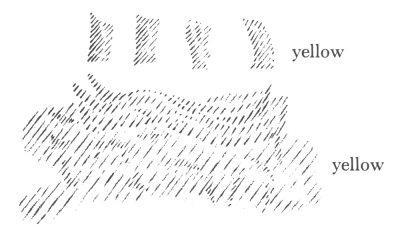
These spiritual counterparts of the consonants, however, do not live between the vowels but in them. In languages on earth the consonants and vowels live side by side. The consonants are lost with the ascent into the spiritual world. You live in a singing worlds of vowels. You yourself actually stop singing; it sings. The world itself becomes universal song. The soul-spirited substance of this vowel element is colored by the spiritual counterparts of the consonants that dwell within the vowels. Here on earth, for example, there is an a tone and a c-sharp tone in a certain octave. As soon as one ascends to the spiritual world, there is not just one a or one c-sharp of a certain scale; instead, there are untold numbers of them, not just of different pitch but of different inward quality. It is one thing if a being of the hierarchy of angels utters an a, another when an archangel or yet another hierarchical being says it. Outwardly it is always the same revelation, but inwardly the revelation is ensouled. We thus can say that here on earth we have our body (sketch on left, white) and a vowel tone (red) pushes against it. Beyond, in the spiritual world, we have the vowel tone (sketch on right, red), and the soul penetrates into it and lives in it so that the tone becomes the soul's body.
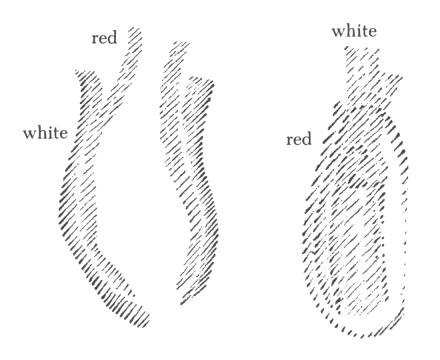
You are now within the universal music, the song of the universe; you are within the creative tone, the creative world. Picture the tone here on earth, even the tone that reveals itself as sound: on earth it lives in the air. The scientific concept, however, that the vibration of the air is the tone is a naïve concept indeed. Imagine that here is the ground and that someone stands on the ground. Surely the ground is not the person, but it must be there so that the person can stand on it; otherwise he could not be there. You would not want to comprehend man, however, by the ground he stands on. Likewise, tone needs air for support. Just as man stands on the firm ground, so—in a somewhat more complicated way—tone has its ground, its resistance, in the air. Air has no more significance for tone than the ground for the person who stands on it. Tone rushes toward air, and the air makes is possible for tone to “stand.” Tone itself, however, is something spiritual. Just as the human being is different from the earthly ground on which he stands, so tone differs from the air on which it rises. Naturally it rises in complicated ways in manifold ways.
On earth, we can speak and sing only by means of air, and in the air formations of the tone element we have an earthly reflection of a soul-spiritual element. This soul-spiritual element of tone belongs in reality to the super-sensible world, and what lives here in the air is basically the body of tone. It is not surprising, therefore, that one rediscovers tone in the spiritual world, where it is stripped of its earthly garment, the earthly consonants. The vowel element, the spiritual content of tone as such, is taken along when one ascends into the spiritual world, but now it becomes inwardly filled with soul. Instead of being outwardly formed by the element of consonants, the tone is inwardly filled with soul. This runs parallel to one's becoming gradually accustomed to the spiritual world.
Picture how man passes through the portal of death. Soon he leaves the consonants behind, but he experiences the vowels, especially the intonation of vowels, to a greater degree. He no longer feels that singing is produced by his larynx but that singing is all around him, and he lives in each tone. This is already the case the very first few days after man passes through the portal of death. He dwells, in fact, in a musical element, which is an element of speech at the same time. More and more of the spiritual world reveals itself in this musical element, which is becoming imbued with soul.
As I have explained to you, when man has passed through the portal of death, he passes at the same time from the earthly world into the world of the stars. Though it appears that I am speaking figuratively, this description is a reality. Imagine the earth, surrounding it the planets, and beyond them the fixed stars, which are traditionally pictured, for good reason, as the Zodiac.
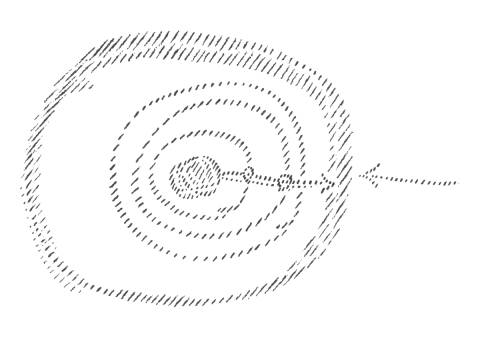
From earth, man views the planets and fixed stars in their reflections; we therefore say that earthly man sees them from the front. The Old Testament expresses this in a different way. When man moves away from the earth after death, he gradually begins to see the planets as well as the fixed stars from behind, as if were. He no longer sees these points or surfaces of light that are seen from the earth; instead, he sees the corresponding spiritual beings. Everywhere he sees a world of spiritual beings. Where he looks back at Saturn, Sun, Moon, Aries, or Taurus, he sees from the other side spiritual beings. Actually, this seeing is also a hearing; and just as one can say that one sees Moon, Venus, Aries, or Taurus from the other side, from behind, so one can say that one hears the beings who have their dwelling places in these heavenly bodies resound into cosmic space.
Picture this whole structure—it sounds as if I speak figuratively, but it is not so, this is a reality; imagine yourself out there in the cosmos: the planetary world further away, the Zodiac with its twelve constellations nearer to you. From all these heavenly bodies it sings to you in speaking, speaks in singing, and your perception is actually a hearing of this speaking-singing, singing-speaking. When you look toward the constellation of Aries you have a soul-consonant impression. Perhaps you behold Saturn behind Aries: now you hear a soul-vowel. In this soul-vowel element, which radiates from Saturn into cosmic space, there lives the soul-spiritual consonant element of Aries or Taurus. You therefore have the planetary sphere that sings in vowels into cosmic space, and you have the fixed stars that ensoul this song of the planetary sphere with consonant elements. Vividly picture the more serene sphere of the fixed stars and behind it the wandering planets. As a wandering planet passes a constellation of fixed stars, not just one tone but a whole world of tones resounds, and another tone world sounds forth as the planet moves from Aries to Taurus. Each planet, however, causes a constellation to resound differently. You have in the fixed stars a wonderful cosmic instrument, and the players of this instrument of the Zodiac and fixed stars are the gods of the planets beyond.
We can truly say that, just as man's walk was shaped for earthly conditions out of cosmic, spiritual orientation, so his speech was shaped for earthly conditions. When man takes speech back into song, he moves closer to the realm of pre-earthly existence, from whence he was born into earthy conditions. It is human destiny that man must adapt himself to earthly conditions with birth. In art, however, man takes a step back, he brings the earthly affairs surrounding him to a halt; once again he approaches the soul-spiritual element from which he emerged out of pre-earthly existence.
We do not understand art if we do not sense in it the longing to experience the spiritual at least in the revelation of beautiful appearance. Our fantasy, which give rise to the artistic, is basically nothing but the pre-earthly force of clairvoyance. Just as on earth tone lives in the air, so what is actually spiritual in pre-earthly existence lives for the soul element in the earthly reflection of the spiritual. When man speaks, he makes use of his body: the consonant element in him becomes the sculptural form of the body; and the stream of breath, which does not pass into solid, sculptural form, is used by the soul to play on this bodily instrument.
We can, however, direct toward the divine what we are as earthly, speaking human beings in two ways. Take the consonantal human organism; loosen it, as it were, from the solid imprint, which it has received from the earthly forces of gravity or the chemical forces of nutrients; loosen what permeates the human being in a consonantal way! We may indeed put it like that. When a human lung is dissected, one finds chemical substances that may be examined chemically. That is not the lung, however. What is the lung? It is a consonant, spoken out of the cosmos, that has taken on form. Put the human heart on a dissecting-table; it consists of cells that can be examined in relation to their chemical substances. That is not the heart, however; the heart is another consonant uttered out of the cosmos. If one pictures in essence the twelve consonants as they are spoken out of the cosmos, one has the human body. This means that if one has the necessary clairvoyant imagination to observe the consonants in their relationships, the complete shape of the human body's sculptural form will arise. If one therefore extracts from the human being the consonants, the art of sculpture arises; if one extracts from the human being the breath, which the soul makes use of in order to play on the instrument in song, if one extracts the vowel element, the art of music, of song, arises.
From the consonant element extracted from the human being, the form arises, which we must shape sculpturally. From the vowel element extracted from the human being arises the musical, the song element, which we must sing. Man, as he stands before us, on earth, is really the result of two cosmic arts. From one direction derives a cosmic art of sculpturing, from the other comes a musical and song-like cosmic art. Two types of spiritual beings fuse their activities. One brings forth and shapes the instrument, the other plays on the instrument.
No wonder that in ancient times, when people were still aware of such things, the greatest artist was called Orpheus. He actually possessed such mastery over the soul element that not only was he able to use the already formed human body as an instrument, but with his tones he could even mold unformed matter into forms that corresponded to the tones.
You will understand that when one describes something like this one has to use words somewhat differently from what is customary in today's prosaic age; nevertheless, I did not mean all this figuratively or symbolically but in a very real sense. The matters are indeed as I described them, though the language often needs to be more flexible than it is in today's usage.
The subject of today's lecture was intended by me as a greeting to our two artists2The two artists and the concert refer to the recital by the sisters Svardstrom in the Goetheanum at that time. who have delighted us with their fine talents. We shall attend tomorrow's concert, my dear friends, with an attitude to which will be added an anthroposophical mood of soul, something that should inform all our endeavors.

